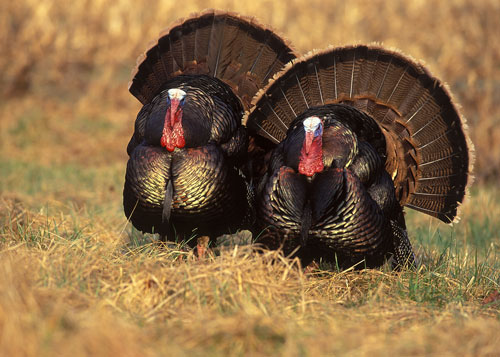A safe turkey hunter is much like a safe driver—you must stay on the defensive when you’re mimicking the sounds of wild turkeys in the woods. Also, keep in mind that a safe hunter is an effective hunter.

Consider the following this spring:
- Leave the area if you suspect another hunter is already working the same bird.
- Resist the urge to stalk turkey sounds. It is nearly impossible to sneak up on a turkey. It is also unethical and could lead to an accident.
- Select a spot that is in open timber rather than thick brush; wearing camouflage clothing and eliminating movement is more critical to success than hiding in heavy cover.
- Sit against a large stump, blow-down, tree trunk, or rock that is wider than your shoulders and higher than your head when calling wild turkeys.
- Never wear bright colors, especially not red, white, blue, or black because these are the colors of a wild turkey gobbler. Watch out for red, white, or blue on your socks, T-shirts, hooded sweatshirts, hats, bandannas, etc. Wear dark undershirts and socks, and pants long enough to be tucked into boots.
- Remain still and speak in a loud, clear voice to announce your presence to other hunters if necessary. Never move, wave, or make turkey sounds to alert another hunter of your presence.
- Keep your hands and head camouflaged when calling.
- Maintain a clear field of view when using a camouflage blind or netting.
- Ensure your decoy is not visible when you are transporting it. Stash the decoy in your vest and make sure the head is not sticking out. If you harvest a wild turkey during your hunting trip, you also should cover the bird’s head and body when carrying it out from your hunting spot.
The National Wild Turkey Federation is committed to making hunter safety a top priority. Thanks to the cooperative efforts between members of the NWTF’s National Turkey Hunting Task Force and governmental agencies and hunting associations, the number of turkey hunting incidents continues to decrease even as turkey hunters flock to the woods in increasing numbers. Spring turkey hunting incidents have decreased from a high of 8.1 per 100,000 in 1991 to a low of 2.95 per 100,000 in 2001, the most recent year this data was updated.
For more information about turkeys and turkey hunting, visit the Federation’s website at www.nwtf.org.






